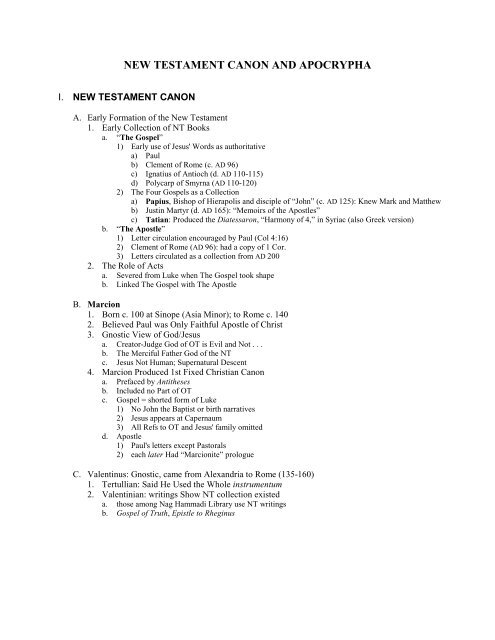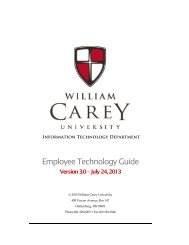New Testament Canon And Apocrypha - William Carey University
New Testament Canon And Apocrypha - William Carey University
New Testament Canon And Apocrypha - William Carey University
You also want an ePaper? Increase the reach of your titles
YUMPU automatically turns print PDFs into web optimized ePapers that Google loves.
NEW TESTAMENT CANON AND APOCRYPHA<br />
I. NEW TESTAMENT CANON<br />
A. Early Formation of the <strong>New</strong> <strong>Testament</strong><br />
1. Early Collection of NT Books<br />
a. “The Gospel”<br />
1) Early use of Jesus' Words as authoritative<br />
a) Paul<br />
b) Clement of Rome (c. AD 96)<br />
c) Ignatius of Antioch (d. AD 110-115)<br />
d) Polycarp of Smyrna (AD 110-120)<br />
2) The Four Gospels as a Collection<br />
a) Papius, Bishop of Hierapolis and disciple of “John” (c. AD 125): Knew Mark and Matthew<br />
b) Justin Martyr (d. AD 165): “Memoirs of the Apostles”<br />
c) Tatian: Produced the Diatessaron, “Harmony of 4,” in Syriac (also Greek version)<br />
b. “The Apostle”<br />
1) Letter circulation encouraged by Paul (Col 4:16)<br />
2) Clement of Rome (AD 96): had a copy of 1 Cor.<br />
3) Letters circulated as a collection from AD 200<br />
2. The Role of Acts<br />
a. Severed from Luke when The Gospel took shape<br />
b. Linked The Gospel with The Apostle<br />
B. Marcion<br />
1. Born c. 100 at Sinope (Asia Minor); to Rome c. 140<br />
2. Believed Paul was Only Faithful Apostle of Christ<br />
3. Gnostic View of God/Jesus<br />
a. Creator-Judge God of OT is Evil and Not . . .<br />
b. The Merciful Father God of the NT<br />
c. Jesus Not Human; Supernatural Descent<br />
4. Marcion Produced 1st Fixed Christian <strong>Canon</strong><br />
a. Prefaced by Antitheses<br />
b. Included no Part of OT<br />
c. Gospel = shorted form of Luke<br />
1) No John the Baptist or birth narratives<br />
2) Jesus appears at Capernaum<br />
3) All Refs to OT and Jesus' family omitted<br />
d. Apostle<br />
1) Paul's letters except Pastorals<br />
2) each later Had “Marcionite” prologue<br />
C. Valentinus: Gnostic, came from Alexandria to Rome (135-160)<br />
1. Tertullian: Said He Used the Whole instrumentum<br />
2. Valentinian: writings Show NT collection existed<br />
a. those among Nag Hammadi Library use NT writings<br />
b. Gospel of Truth, Epistle to Rheginus
NT <strong>Canon</strong> and <strong>Apocrypha</strong> page 2<br />
D. Marcionite Heresy Caused the Catholic Church to Consider the <strong>Canon</strong><br />
1. Anti-Marcionite Prologues to the Gospels<br />
2. The Muratorian Fragment (ca. AD 170)<br />
a. Latin List of <strong>Canon</strong>ical Books Published 1740 by Muratori<br />
b. Omits: Heb, James, 1-2 Pet, A Letter of John<br />
c. Adds: Apocalypse of Peter, Wisdom of Solomon, [Shepherd of Hermas]<br />
E. Irenaus: Bishop of Lyon (ca. AD 180)<br />
1. Does Not Give Formal List of NT Books<br />
a. Cited by Eusebius Ecclesiasticl History 5. 8. 1-8.<br />
b. Uses all Except Philemon, Heb, Jam, 2 Pet, 3 Jn, Jude<br />
c. Quotes Shepherd of Hermas (“Scripture”) & Wisdom of Solomon<br />
2. NT Collection + OT = Christian Bible from Irenaus On<br />
F. Tertullian of Carthage (fl. AD 196-212) Wrote in Latin<br />
1. 1st Refer to Books as <strong>New</strong> Covenant (Latin instrumentum; testamentum)<br />
2. Led to Use of English Word “<strong>Testament</strong>”<br />
G. Origen (AD 185-254): Alexandria to Caesarea<br />
1. Cited by Eusebius Ecclesiastical History 6. 25. 3-14<br />
2. Distinguished Acknowledged Books from Disputed Ones<br />
3. Acknowledged: Gospels, Acts, Pauls Epistles, 1 Pt, 1 Jn, Rev<br />
4. Disputed: Hebrews, 2 Peter, 2-3 John, James, Jude, Epistle of Barnabas, the Shepherd of<br />
Hermas, the Didache, Gospel According to the Hebrews<br />
H. Eusebius: Bishop of Caesarea (AD 314-339)<br />
1. Greatest Work = Ecclesiastical History ; Church History to AD 313<br />
2. Three Categories of NT Books<br />
a. Acknowledged: Gospels, Acts, Paul's Epist, 1 Jn, 1 Pet, Rev<br />
b. Disputed: James, Jude, 2 Peter, 2-3 John<br />
c. Spurious (Uncanonical): Acts of Paul, Shepherd of Hermas, Apocalypse of Peter, Didache, [Rev],<br />
Gospel Acc to Hebrews<br />
3. Rejected Books: Gospels of Peter, Thomas, and Matthias; Acts of Paul, Peter, <strong>And</strong>rew, John,<br />
and Thomas<br />
4. Constantine's Fifty Bibles<br />
I. The Early Uncial MSS: General Letters Follow Acts<br />
1. Codex Sinaiticus: Includes Epistle of Barnabas, Shepherd<br />
2. Codex Alexandrinus: Includes 1-2 Clement, [Psalms of Solomon]<br />
J. Athanasius<br />
1. Bishop of Alexandria<br />
2. Festal Letter of Easter, AD 367: Announced Date of Easter<br />
a. Includes Statement about <strong>Canon</strong><br />
b. 1st known list of 27 NT books, and only those 27<br />
c. Didache, Shepherd Could Also be Read in Church<br />
K. The East After Athanasius<br />
1. Chrysostom<br />
a. (Bishop of Constantinople 397-407)<br />
b. 1st to call OT+NT “The Books,” ta Biblia (“The Bible”)<br />
2. Eastern Churches More Diverse in <strong>Canon</strong> than West after 400<br />
3. No Syriac Bible included 2 Pt, 2-3 Jn, Jude, Rev until 508
NT <strong>Canon</strong> and <strong>Apocrypha</strong> page 3<br />
L. The West in the Fourth Century<br />
1. Athanasius' Influence in Rome (340)<br />
a. Promoted Hebrews (& others) as Authentic<br />
b. Hilary (d. 367): 1st Western Writer to Accept James<br />
c. 2 Pt, 2-3 Jn, Jude, Rev Gradually Accepted<br />
2. Jerome (ca. 345-420): Latin Vulgate NT had the 27 Books<br />
3. Augustine (AD 354-430): Inherited the <strong>Canon</strong> as “Given”<br />
4. Council (or Synod) of Hippo in AD 393<br />
a. Confirmed (not established) the recognized 27<br />
b. Reported by Third Council of Carthage (AD 397)<br />
M. Criteria for <strong>Canon</strong>ization of <strong>New</strong> <strong>Testament</strong> Books<br />
1. Apostolic Authorship or Authority<br />
a. Direct Apostolic Authorship<br />
b. Indirect Apostolic Authority: Associates (Mark, Luke, Jude)<br />
c. Not Always Easy to Discern<br />
2. Antiquity<br />
a. Composed During NT Period<br />
b. Good, Later Works Excluded: i.e., Shepherd of Hermas<br />
3. Orthodoxy<br />
a. Adherence to Apostolic Faith (esp. Irenaeus)<br />
b. Excluded Heretical (Gnostic, Docetic) Books<br />
4. Catholicity: General Recognition; Accepted by Majority<br />
5. Inspiration<br />
a. An Inherent Spiritual Quality or Authority<br />
b. The Ability to Change Lives<br />
c. A Book's Authority vs. <strong>Canon</strong>icity<br />
1) Not Authoritative Because <strong>Canon</strong>ical<br />
2) <strong>Canon</strong>ical Because Authoritative<br />
II. THE APOSTOLIC FATHERS<br />
A. Epistles<br />
1. 1 Clement (ca AD 96)<br />
a. From Clement (Bishop) on Behalf of Church in Rome<br />
b. To Church in Corinth; Mentions 1 Cor, Cites Heb<br />
c. Irenaeus, Clement of Alex, and Origen: <strong>Canon</strong>ical<br />
2. Epistle of Barnabas<br />
a. Prob 2nd cent; Pseudepigraphical<br />
b. Clement and Origen: <strong>Canon</strong>ical?<br />
3. Seven Letters of Ignatius; Written on Way to Martyrdom (d. AD 98-117)<br />
a. To the Ephesians<br />
b. To the Magnesians<br />
c. To the Trallians<br />
d. To the Romans<br />
e. To Polycarp, Bishop of Smyrna<br />
f. To the Smyrnans<br />
g. To the Philadelphians<br />
4. Letter of Polycarp to the Philippians (ca AD 117)
NT <strong>Canon</strong> and <strong>Apocrypha</strong> page 4<br />
B. Instructions<br />
1. The Shepherd of Hermas<br />
a. Early 2nd cent, Rome; an Allegory<br />
b. Irenaeus, Clement of Alex, (Origen?): <strong>Canon</strong>ical<br />
2. The Didache or Teachings of the Twelve Apostles<br />
a. Early 2nd cent Manual of Church Discipline<br />
b. <strong>Canon</strong>ical Status Disputed by Some: Origen<br />
3. 2 Clement: an Early Sermon/Homily<br />
C. Martyrdom of Polycarp<br />
III. OTHER WORKS<br />
A. <strong>Apocrypha</strong>l Gospels<br />
1. Gospel of Peter: 2nd Cent; Text Found in 1886-87<br />
2. Infancy Gospel of Thomas: Jesus 5-12 Years<br />
3. Protevanglium of James: Events Leading to Mary's Birth<br />
4. Jewish-Christian Gospels<br />
a. Gospel of the Hebrews<br />
b. Gospel of the Nazoreans: Aramaic Version of Matthew?<br />
c. Gospel of the Ebionites: A Harmony<br />
5. The Gospel of Thomas<br />
a. Collection of Jesus' Sayings<br />
b. With Coptic Nag Hammadi Texts<br />
6. Fragmentary Lost Gospels: Oxyrhynchus 840; Egerton 2<br />
B. <strong>Apocrypha</strong>l Acts<br />
1. Acts of Peter: 2d-3d Cent; Peter vs. Simon Magus in Rome<br />
2. Acts of Paul: Composition of Different Accounts<br />
a. Acts of Paul and Thecla<br />
b. Martyrdom of Paul<br />
3. Acts of John: Activity in Asia; Gnostic/Docetic<br />
4. Acts of <strong>And</strong>rew: 3rd Cent; Martyrdom for Ascetic Practice<br />
5. Acts of Thomas: Thomas in India; Ascetic/Celibate Life<br />
C. <strong>Apocrypha</strong>l Letters<br />
1. 3 Corinthians: Circulated in Syriac/Armenian Churches<br />
2. Letter to the Laodiceans: Popular in Medieval Church<br />
3. Pseudo-Titus<br />
D. Apocalypses<br />
1. Apocalypse of Peter: Muratorian Fragment Includes<br />
2. Apocalypse of Paul: 4th-5th Cent; Vivid Heaven, Hell<br />
3. Apocalypse of Thomas: 5th Cent; Eschatological Signs
NT <strong>Canon</strong> and <strong>Apocrypha</strong> page 5<br />
IV. GNOSTIC LITERATURE<br />
A. Gnostic Tenets<br />
1. Sharp Dualism: Transcendent God vs. Ignorant Creator<br />
2. Material World = Evil<br />
3. Sparks of Divinity Caught in Bodies of the Spiritual<br />
4. Redeemer Brings Gnosis (Knowledge) of Spiritual Nature<br />
5. Gnostic Attitudes Toward the Flesh<br />
a. Some Indulged in Licentious Behavior<br />
b. Most Suppressed Flesh; Ascetic Sexually<br />
B. Knowledge of Gnostics/Literature until 19th Century Depended on Writings of Irenaus,<br />
Hippolytus, Origen, etc.; More Recently, MSS of Gnostic Writings Have Come to Light<br />
C. Nag Hammadi Codices<br />
1. Found at Nag Hammadi in Upper Egypt in 1945<br />
2. Coptic MSS of Gnostic Community from ca. AD 400<br />
3. About 50 works in 12 Codices; Some Texts:<br />
a. Works of Valentinus?<br />
1) The Gospel of Truth: Ignorance; Man's Lost State<br />
2) Letter of Rheginos: Resurrection not Physical<br />
3) Gospel According to Philip: Discusses Sacraments<br />
b. The Gospel According to Thomas: Above, III.A.5<br />
c. The Apocryphon of John: Origins of the Universe<br />
d. Revelation of Adam: Adam tells Seth About Noah<br />
e. Hypostasis of the Archons: Interpretation of Genesis<br />
f. Non-Gnostic: Teachings of Silvanus; Plato's Republic








